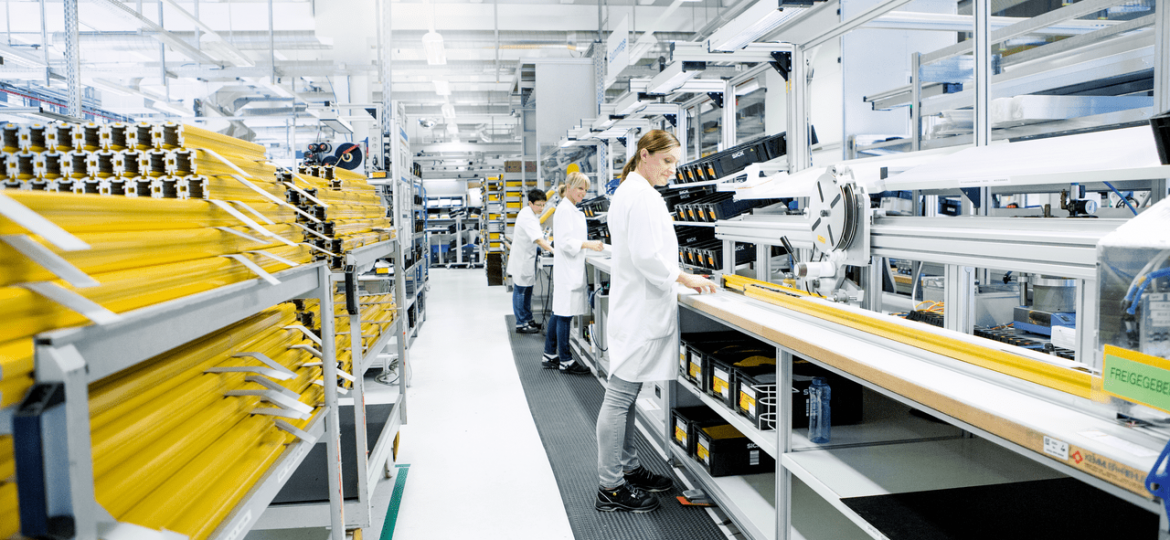
SICK, one of the world’s leading solution providers for sensor-based applications for industrial applications with its headquarters in Waldkirch im Breisgau, Germany, like many other manufacturing companies, is facing the challenge of reconciling increasing quantities, a shortage of skilled workers, and cost increases. In production, the favored solution is not to open additional assembly lines, but to work more efficiently with the existing lines, says Waldemar Merkel from the central efficiency team at SICK. Whether it’s bottleneck costing, automation solutions, or design changes to the product – the basis are data from the MTM analysis, he says. “We use the method standard to identify potential in the processes and derive concrete optimization approaches – and have been doing so for 30 years,” says Merkel.
The way to the standard: Central efficiency team initiales improvement projects at all sites
At SICK AG, every business center is to have a time management expert, i.e., an MTM Practitioner with a “Blue Card”. Since 2020, the efficiency team has been working with these MTM experts on improvement and lean projects at various sites. In a current efficiency project on waiting times in the manual assembly process, the use of the MTM-UAS® process building block system has succeeded in identifying so much potential that waiting times have not only been reduced, but eliminated completely.
Concrete effects also on manufacturing costs
Merkel has experienced several times in his professional life that the MTM method standard makes all the difference. At a previous employer, three new assembly lines were originally to be ordered. However, Merkel’s analysis of the assembly processes using MTM-UAS® revealed a need for only 1.75 lines. “The order was still able to be adjusted to two assembly lines in time, and the assembly area required in the production plant was also reduced. This had a positive effect on manufacturing costs,” he describes.
“MTM IS MORE THAN TIME DETERMINATION”
The MTM method standard has a high priority at SICK AG. “As soon as you mention that MTM is behind the numbers, i.e. that facts count rather than gut feelings, there are no big discussions,” says the industrial engineer. The MTM experts are convinced of the method – also because of the results, he says. “Colleagues report potential savings in PEP projects of up to 5 minutes per assembly.” However, MTM should not only be known to a small circle of experts. “We also want to make the method known in the company beyond time studies or target times, because MTM is more than time determination.” To this end, the MTM experts have launched an internal marketing campaign together with Merkel’s mentor Andreas Wernet. The goal is to visualize the MTM@SICK target image via a common element and to bring it to implementation.
The action is already bearing fruit. For example, a small group has come together that is passionate about intralogistics and has launched a pilot project using MTM logistics data.
First internal MTM practitioner training
In the 30th year of MTM application at SICK AG, the first internal MTM-Practitioner training courses are also planned. “We want to ensure that the MTM method is applied correctly in the company, that the rules are followed. This requires MTM practitioner training according to the standards of the MTM ASSOCIATION e. V., including the necessary application practice,” says Merkel, who will also conduct the courses. The 2023 dates have already been entered in the training roadmap.
“Away from the method bouquet to a standard”
The MTM application at SICK AG is digitally supported by the software solutions TiCon Base, MTM-Easy® and a Standard Time Monitoring (STM) developed by Merkel. The latter provides an overview of the proportion of MTM already in use at the individual SICK production plants. “Then you can ask: Why are we not doing as well as we could be in this or that area – and what do we need to do?” Internal benchmarking via STM helps very well to work on the issues, he says. “We want to move away from a bouquet of methods and toward a standard. Our goal is to continuously increase the share of the MTM method,” Merkel says. First in the German plants and then at SICK production sites in Hungary, Malaysia/Singapore, and the USA.
Would you like to learn more about the introduction and application of MTM in the company? Then read on HERE or contact us.
Your contact:
Ralf Jaehnke, Director Business Unit Consulting, Deutsche MTM-Gesellschaft mbH, e-mail: ralf.jaehnke@mtm.org